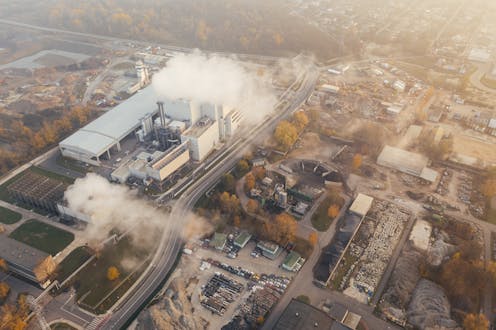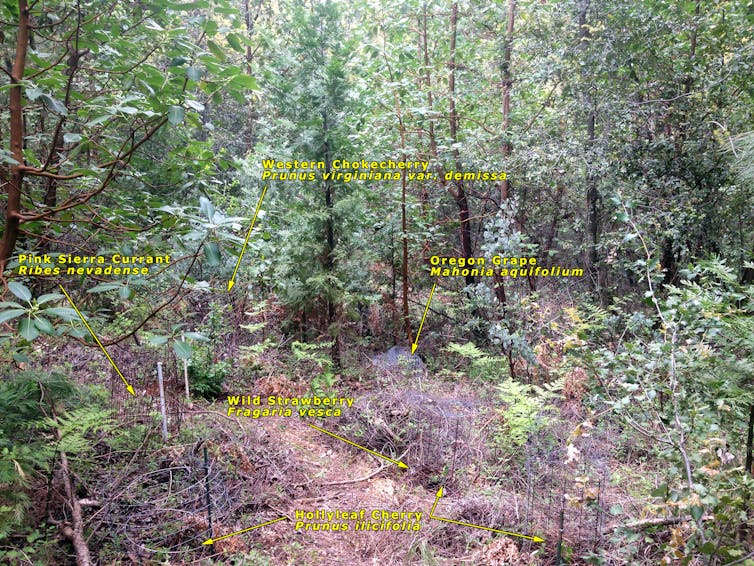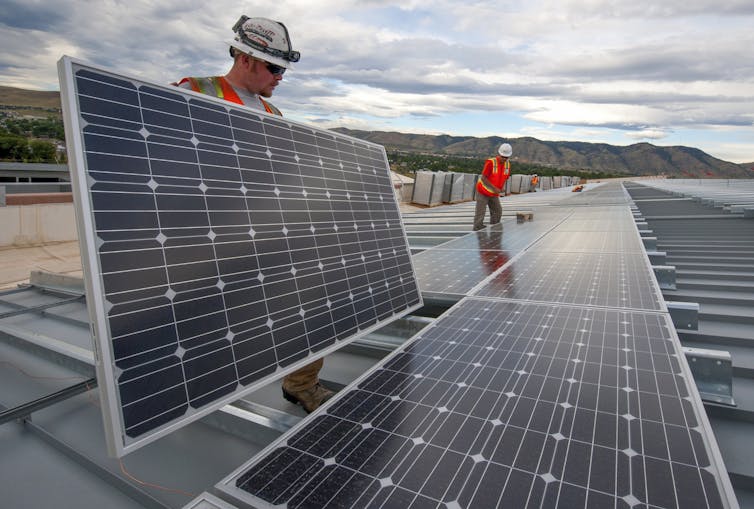
As the latest report from the UN’s Intergovernmental Panel on Climate Change (IPCC) makes clear makes clear, the 2020s must be a decade of transformation if we are to stand any chance of achieving the goals of the Paris Agreement.
Carbon capture and storage (CCS) is widely anticipated to play a key role in this transformation by helping to cut carbon emissions worldwide. But relying on CCS may overshadow solutions that focus on reducing our energy demand and making behavioural changes that put sustainability first.
Over the coming years, global greenhouse gas emissions need to fall rapidly in accordance with the Carbon Law, a relatively simple equation developed by scientists to achieve decarbonisation: halving emissions by 2030, then continuing to halve them every decade until 2050 to reach a level that can be stored by “natural carbon sinks” such as forests, pastures and peatlands.
Current strategies to rapidly cut emissions have proved inadequate. Many governments are now looking to CCS technologies that capture and store carbon dioxide (CO₂) released by burning fossil fuels and other industrial processes. CCS also includes systems that capture CO₂ from burning organic matter (BECCS) or directly from the atmosphere.
CCS may be a critical technology to cut emissions in some sectors. For example, cement production is currently responsible for 8% of global CO₂ emissions. Of this, 60% are “process emissions”, meaning they can’t be avoided, even if fossil fuels stop being used in the cement manufacturing process entirely. This is where CCS can step in to capture that carbon.
Yet CCS has been struggling to get off the ground, with more than 80% of projects ending in failure thanks to complicated infrastructure and a lack of policy support. Relying on CCS too much could therefore be risky.
Model evidence
Along with the Exponential Roadmap Initiative team, author Avit Bhowmik has modelled different ways in which we might be able to limit global warming to 1.5°C by 2100.
Together, we’ve mapped greenhouse gas emissions across six sectors – energy, industry, buildings, transport, food, and agriculture and forestry – to assess whether existing solutions, including circular business models, renewable energy tech, and low-carbon heating and cooling systems, can eliminate emissions without using CCS.
We found that if solutions that don’t rely on CCS were implemented within Carbon Law guidelines, global emissions could be cut from 54 billion metric tonnes in 2020 to 34 billion metric tonnes in 2030.
With the accelerating development of renewable energy, energy sector emissions could be reduced by three billion metric tonnes by 2030. In the buildings sector, automating energy usage and retrofitting buildings could cut emissions by five billion metric tonnes by 2030. And electric vehicles, digital carpooling services and remote meeting platforms could cut another 3.5 billion metric tonnes from the transport sector.

What’s more, adding nature-based solutions such as managing cattle grazing and rebuilding forests could not only rapidly reduce emissions by preventing land degradation, but could also add 9.1 billion metric tonnes of capacity to carbon sinks. For example, creating “food forests” – layered forests with crops built in – could sequester up to one billion metric tonnes of greenhouse gases annually.
If we manage to put these plans into practice, we’d be able to achieve net zero emissions in the next two decades and significantly reduce our reliance on CCS. But that’s only half of the story.
Renewable power
The cost of renewables has plummeted over the past decade. Wind and solar power are now the cheapest forms of electricity in most parts of the world. But economic models have struggled to keep pace, sometimes using overly pessimistic renewables costs. New research by author Neil Grant and colleagues explores what happens when these cost assumptions are updated to reflect the amazing progress of the past decade.
We found that cheap renewables reduce the need for technologies such as CCS, with the economic value of CCS falling by 15-96% by 2050. However, this effect varies strongly across sectors.

For example, while cheap renewables slash the value of CCS in electricity and hydrogen production by 61-96%, CCS remains valuable in cement production and CO₂ removal, where its value only falls 15-36%. It seems like targeting CCS where it’s most needed could be a better strategy: less “spray and pray”, more “select and perfect”.
Discounting climate
Models of a low-carbon future need to decide how to spread the effort of tackling climate change over the next century. They often use “discount rates” to achieve this. Discount rates determine how a dollar’s worth of action today – for example, a dollar spent installing a wind turbine – compares to a dollar’s worth of action in the future.
A higher discount rate means it’s cheaper to spend the dollar in the future, creating an incentive to delay that action. The problem is that many models still use relatively high discount rates of 4-5%. This leads to a tendency to do less now – and compensate for it later.
Neil’s research shows that when lower discount rates of 1% are used – to reflect the importance of future generations’ wellbeing – the value of CCS plummets across sectors. In particular, the value of BECCS is cut by more than half. Avoiding this means BECCS, while still a useful tool, becomes much less valuable.
While capturing carbon will be essential in tackling the climate crisis, it shouldn’t be used to delay action now. We should update our models to better consider the needs of future generations when designing climate policy, since large-scale reliance on carbon capture might be a dangerous game to play.
Neil Grant receives funding from NERC under the Science and Solutions for a Changing Planet DTP.
Avit K Bhowmik does not work for, consult, own shares in or receive funding from any company or organization that would benefit from this article, and has disclosed no relevant affiliations beyond their academic appointment.
This article was originally published on The Conversation. Read the original article.







